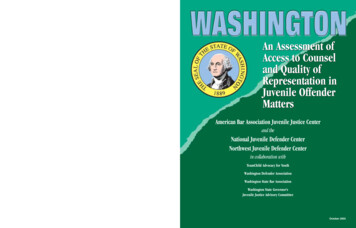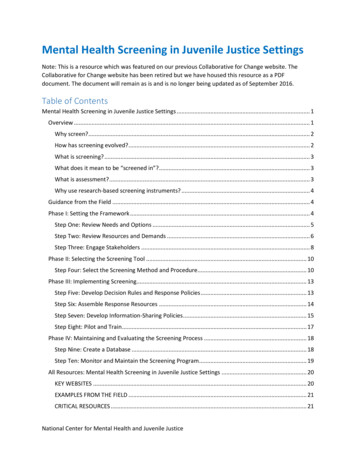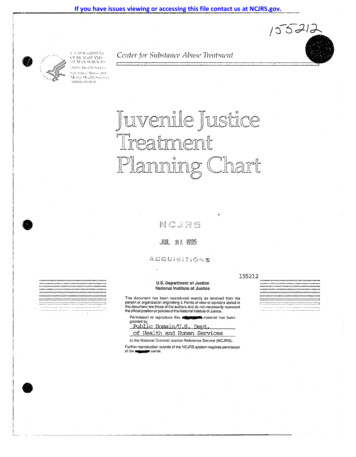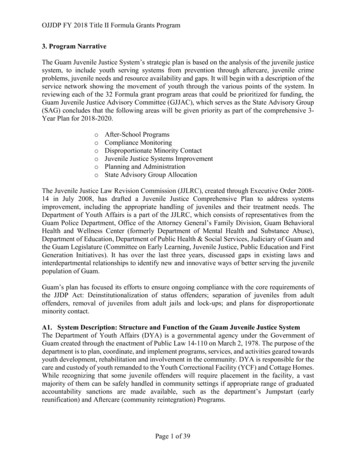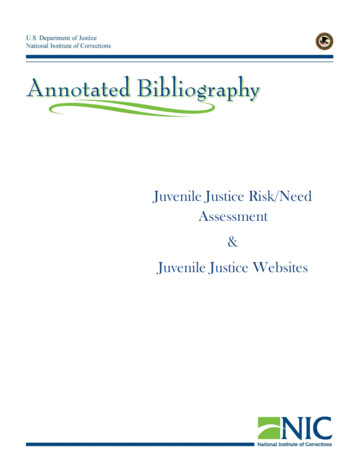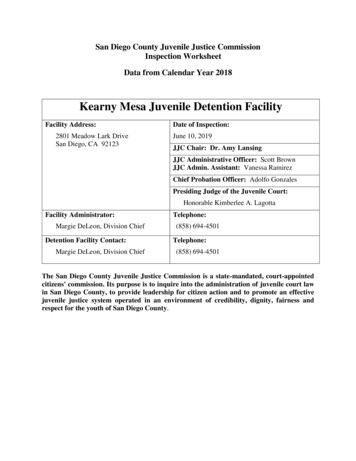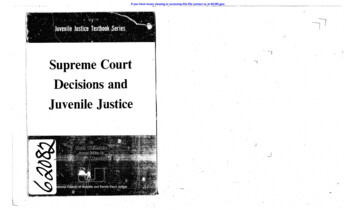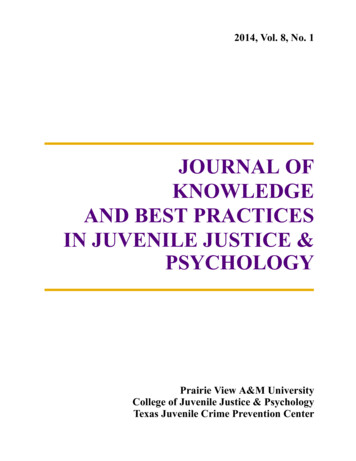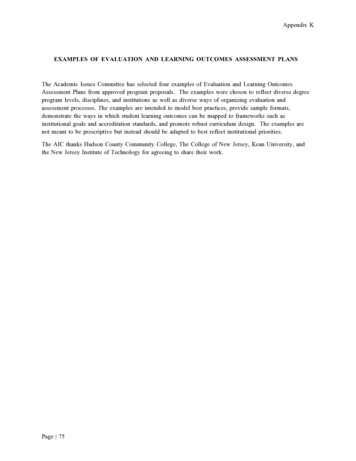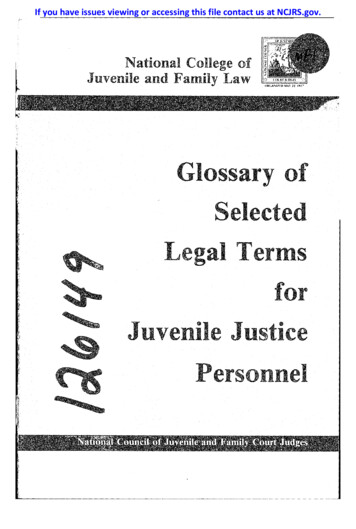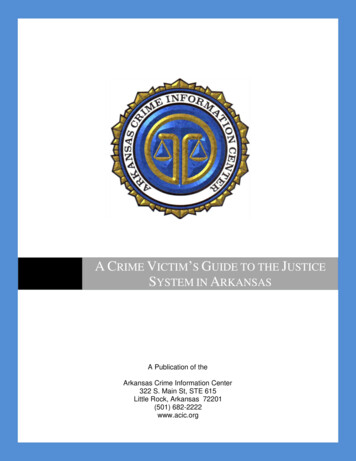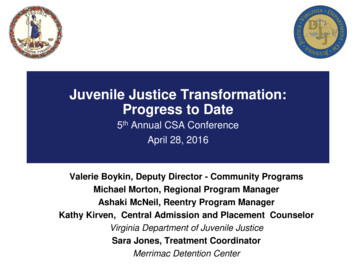
Transcription
Juvenile Justice Transformation:Progress to Date5th Annual CSA ConferenceApril 28, 2016Valerie Boykin, Deputy Director - Community ProgramsMichael Morton, Regional Program ManagerAshaki McNeil, Reentry Program ManagerKathy Kirven, Central Admission and Placement CounselorVirginia Department of Juvenile JusticeSara Jones, Treatment CoordinatorMerrimac Detention Center
Transformation PresentationAgenda Background Transformation Progress Next Steps Video on Community Treatment Model2
Intake cases have decreased by37.6% (25,492 cases) since FY 2006.3
Admissions to direct care* have decreased by55.8% (490 juveniles) since FY 2006.* The direct care population includes all committed juveniles regardless of placement.4
Admission TrendsFY 2015 through FY 2016** Admission data for March was captured on March 31, 2016 and, therefore, are incomplete.5
Juvenile Direct Care PopulationForecast (FY 3FY15FY17FY19FY216
Most Serious CommittingOffense by Severity*Offense SeverityFelony Against PersonsFelony Weapons/NarcoticsOther FelonyC1 Misdemeanor Against PersonsOther C1 MisdemeanorParole 01450.1%4.8%29.8%6.7%5.1%3.5%* Percentages do not add to 100% because categories with small percentages are not displayed.201553.4%2.6%29.6%6.7%5.2%2.6%7
African-American youth overrepresentedat every stage of the system.BlackWhite & Other7671565446442924IntakesTotal 10-17populationDetainments Direct CareAdmissionsPopulations involved with DJJ (FY14)IntakesTotal 10-17populationDetainmentsDirect CareAdmissionsPopulations involved with DJJ (FY14)Percent of FY 2012 through FY 2013 juvenile intake cases that received a commitment to direct care by the end of FY 2014.One youth may be committed on the basis of multiple intake complaints. Hispanic ethnicity is not consistently identified inthe intake case data, so the cases categorized as “Black” or “White & other” may include Hispanic youth.8
African-American youth committed attwice the rate of other youth.BlackWhite & other12%Person felony6%7%Narcotics or weapon felony3%7%Other felony4%2%Class 1 person misdemeanor1%Other misdemeanor1%Status offenseViolationAll offenses2%0%0%3%1%3%1%Percent of FY 2012 through FY 2013 juvenile intake cases that received a commitment to direct care by the end of FY2014. One youth may be committed on the basis of multiple intake complaints. Hispanic ethnicity is not consistentlyidentified in the intake case data, so the cases categorized as “Black” or “White & other” may include Hispanic youth.9
Budget cuts eliminated thecontinuum of alternativesVirginia 2005CulpeperMax SecurityClosed 2014Bon AirMax SecurityHanoverMid SecurityRepurposedVirginia 2016BeaumontMax SecurityBarrettMid SecurityClosed 2005Bon AirMax SecurityBeaumontMax Security56 CommunityPlacementSlots *TransitionLiving ProgramClosed 201020 CommunityPlacementSlotsNat BridgeMin SecurityClosed 2009Hampton PlaceHalf Way HouseClosed 2013Abraxas HouseHalf Way HouseClosed 2013Discovery HouseHalf Way HouseClosed 2010Camp New HopeSpecial PlacementClosed 2009VA Wilderness Inst.Special PlacementClosed 2009Oak RidgeSpecial PlacementConsolidatedReception &Diagnostic Center* Includes Community Placement Programs. Detention Reentry beds are not included.10
VA’s use of large facilities out ofstep with national trends85%44%30%14%20032013National Census of Juveniles in Residential Placement (CJRP)20042015VirginiaShare of committed youth housed in facilities with more than 200 bedsShare of Direct Care capacity in facilities with more than 200 beds11
Current Outcomes High recidivism Racial disproportionality 1,500 juveniles (approx. 23%) released from directcare in last 10 years were serving a Department ofCorrections (DOC) sentence as of December 31, 2015.1,500 150,000,000 in juvenile rehabilitation1,500 42,000,000 in DOC annual expense** Virginia DOC Management Information Summary Annual Report, 2015, p.1412
DJJ Transformation PlanReduceReform- Use data andevidence to modifylength of stay (LOS)policy- Convert juvenilecorrectional center (JCC)units to CommunityTreatment Model- Uniform, effective,and data-drivenprobation practices- Improve educational andvocational programming- Develop morealternative placementsfor committed juveniles- Improve familyengagementReplace- Expand the array ofplacement alternatives byreinvesting correctionalsavings- Develop a StatewideContinuum of Services- Build two new facilities thatare safer, closer, smaller in- Enhance reentry planning scale, and built for treatment toand parole servicesreplace current JCC’s13
Transformation Progress:Reduce New LOS Guidelines, Effective October15, 2015 Expansion of Community PlacementProgram and other Alternatives Population Decline Court Service Unit (CSU) PracticeImprovement14
Transformation Progress:CSU Improvement Retraining on existing tools and skillbuilding training to provide or coordinateinterventions Partnerships with local CSB’s More diversion alternatives Stronger connection with JCCs Stronger connections with other CSUs15
The JCC population has fallen by 37% since May2014; the population in JCC alternatives hastripled.524462434Total JCC Alternatives17
Transformation Progress:Reform Converted 9 JCC units to the CommunityTreatment Model (108 residents) Improved educational programming, andstrengthened vocational and job certification Funding and providing transportation forfamily visits to Beaumont and Bon Air JCCsand community placement programs (CPPs)18
Transformation Progress:Reentry Reform One of six states to receive an OJJDPPlanning Grant in 2014 to reform thereentry system One of three states to receive an OJJDPimplementation grant to improve reentryplanning procedures to include greaterfamily involvement New Reentry Procedures21
Transformation Progress:Replace Closed the Reception and DiagnosticCenter on June 30, 2015 Contracted for a new apartment livingprogram in Virginia Beach (8 beds) Issued a Request for Proposal (RFP) forResidential Placement for Girls Issued an RFP for Regional CareCoordinators Contract for seven CPPs for boys and onefor girls as of July 1, 2016 (73 total beds)23
Transformation Progress:Replace Governor’s Proposed Budget– Funding for two new, smaller, and treatment-orientedfacilities (Chesapeake and Hanover)– Reinvestment authority Final Budget:– Reinvestment Authority– Interagency Taskforce to study DJJ capital needs(requires input from Judiciary)– Funding for Chesapeake (after interim report) andplanning for second site.24
Classrooms Not Courtrooms Administration-wide initiative to stem theflow of young people from schools tocourt–––––Training initiativesDelineation of school and resource officer rolesFocus on positive behavioral supports in schoolsBetter data sharing and collectingPolicy change26
DJJ Intake DataDiversions of FirstTime TruancyComplaintsSchool-Based IntakeComplaints*2013-2014School Year2014-2015School Year2015-2016School Yearthrough MarchOverall:20% of first-timetruancy complaint werediverted.Overall:19% of first-timetruancy complaint werediverted.Overall:20% of first-timetruancy complaint werediverted.Non-white juveniles:19% of first-timetruancy complaint werediverted.Non-white juveniles:18% of first-timetruancy complaint werediverted.Non-white juveniles:17% of first-timetruancy complaint werediverted.N/A(Data was not yetcollected.)Between 2/1/15 and8/31/15, 10.2% ofjuvenile intakecomplaints were madeby School Officials(6.5%) or SRO (3.6%)petitioners.16.7% of juvenileintake complaints weremade by SchoolOfficials (10.7%) orSRO (6.0%)petitioners.27
Additional/Future Initiatives: Agency-wide communication skill building Development of a Dispositional DecisionMaking Matrix– Multiple opportunities for stakeholder input– Gradual roll-out and likely regional variations Development of statewide continuum Addressing racial disproportionality VJCCA Reform Violence Prevention28
Court Service UnitsIntake, Probation & ParoleMichael G MortonRegional Program ManagerEastern Region
Court Service UnitsTransformation Activities Intake and DiversionDiversion DataDecision MakingAlternatives to DetentionDJJ Decision Making Tools– Detention Assessment Instrument (DAI)– Youth Assessment Screening Instrument (YASI)– Disposition Matrix32
Intake and Diversion Intake is the front gate and Intake Officers are the “gatekeepers” Research indicates low risk youth reoffend at much lowerlevels, even with no intervention. In fact an over-responsecan do more harm than good. For those reasons we must increase diversion, with riskassessment guiding our diversion decision-making.33
Intake and Diversion Current Use of Diversion Varies Across CSUs. FY 2015 Diversion Data:– Approximately 57,000 total complaints– 80% were diversion eligible– Only 16% of those were diverted(Source: Data Resource Guide, FY2015, page 22) Failure to divert low risk cases can inadvertentlyincrease risk.34
Decision Making There are many key-decision points in our system. Some of ourmost important decisions, including whether to formally charge andwhether to deprive young people of their liberty occur at CSUIntake. When making such important decisions it is important that we doso using structured, objective means. DJJ’s decision-making approach includes a collection ofstandardized instruments and tools that assess risk, promotesafety, and guide decisions. These tools are intended to promoteconsistency, equity, and the use of the least restrictive level oflegal intervention and environment to achieve public safety.35
Alternatives to Detention Intake Officers have the authority to release, place youth in an alternativeto detention, or place in secure detention Continuum of Alternatives:-OutreachEM/GPSDay/Evening Reporting CenterShelter Care36
Decision-Making Tools Detention Assessment Instrument (DAI) and the YouthAssessment & Screening Instrument (YASI). The YASI includes both a Pre-Screen and a FullAssessment. Tools are intended to help ensure the right youths, receivethe right interventions at the right time. Our tools should also help us to differentiate between youngpeople with social, child welfare and treatment needs andyoung people who pose a risk to public safety.37
Detention AssessmentInstrument (DAI) DAI was implemented in 2002 in the 32 State operated CourtService Units and 3 locally operated Court Service Units. The Detention Assessment Instrument indicates whetherjuveniles eligible for pre-dispositional detention should bereleased to parents or other appropriate persons, placed in adetention alternative, or detained. The Detention Assessment Instrument was developed through aconsensus approach and allows for mandatory and discretionaryoverrides. The DAI was validated in 2007 by Scott Reiner, Jared Miller, andTripti Gangal.38
Detention AssessmentInstrument (DAI) Our responsibilities in making Detention placement decisions aresome of our most important decisions. Being detention eligible (by Code)is not the same as beingdetention appropriate. Detention and other secure environments come with inherentdangers and disconnect juveniles from family, school, serviceproviders, pro-social activities and more. Secure detention alsoincreases risk. We must reserve secure detention for juveniles who pose a risk topublic safety or a risk of flight.39
Youth Assessment ScreeningInstrument (YASI) DJJ uses the Youth Assessment &Screening Instrument to assess risk to reoffend. The YASI has two versions, a condensedpre-screen version and a full assessment.42
YASI Pre-Screen The YASI Pre-screen includes a minimum of high predictivestatic & dynamic items (about 30). The items yield classifications of “low”, “moderate”, and“high” risk of future delinquent behavior. The YASI Pre-screen can be used at Intake to informDiversion decisions. The YASI Pre-Screen is intended to rapidly identify “low” riskcases that can be diverted and “moderate” and “high” riskcases that require further assessment or intervention.43
YASI Full Assessment The Youth Assessment and Screening Instrument (YASI ) is an innovativemodel that assesses risk, needs and protective factors in youth populations. Measures both risk and strengths in juvenile populations as well as other high riskyouth. Measures protective factors to help case workers build on the strengths of youthto buffer the negative impact of risk. Includes a case planning component designed to help case workers identify andmonitor the priority targets for behavior change. Produces results quickly and efficiently through web-based software that alsoguides the user through case plan development. Provides an attractive visual method for presenting and sharing assessmentresults.44
YASI Full AssessmentDomains Assessed:1. Legal History2. Family3. School4. Community/Peers5. Alcohol/Drugs6. Mental Health7. Violence/Aggression8. Consequential Thinking Skills9. Attitudes/Beliefs10. Employment/Use of Free Time45
Disposition MatrixOn the HorizonKey Points of the Disposition Matrix: The matrix places youth along a continuum of disposition options and communityoptions. The intensity of Court Service Unit services increases as the risk leveland offense severity increases. Low-Risk Offenders remain in the community with minimal intervention Moderate-Risk Offenders are typically placed in more structured communityprograms High Risk offenders receive probation supervision with evidenced basedpractices and treatment programs (EPICS, ART, T4C, FFT, MST) Residential Placement reserved for the highest risk offenders with violentoffenses47
Community Placement Program (CPP)a Partnership Between theVirginia Department of Juvenile Justice andthe local Juvenile Detention FacilitiesKathy KirvenCentral Admissions & Placement Counselor
CPP OverviewWhat is the Community Placement Program? Partnership with local detention facilities Small and highly structured residential placement withcommunity re-integration planning Residents remain in direct care during stay Focus on skill development and developingcompetency in education, job readiness, life and socialskills.49
CPP OverviewWhich detention centers will participate?Rappahannock – FredericksburgBlue Ridge - CharlottesvilleChesapeake - TidewaterVA Beach – TidewaterMerrimac – WilliamsburgShenandoah – StauntonChesterfield-Central Region50
CPP OverviewWho is eligible for placement in CPP? Males Preferably at least 16 up to 20.6 Both frontend and backend of commitment Low to moderate risk; high risk with protective factors No longer than a 12 month LOS No active DOC or jail time51
CPP Overview Referral Process– Front-end youth: CAP committeeIntake & Assessment PhaseCSU inputStaffing: if youth identified as possible CPPcandidate, the case management review processinitiates CAP referrals go directly to CCRC Pending intakes in the community52
CPP Overview Referral Process– Back-end youth Treatment teams identify youth who have 3 ormore months left to serve on their LOS, completedtreatment, stable behavior Follows case management review process at thefacility level Treatment Team-ICRC-CCRC53
CPP Overview Referral Process– CCRC reviews all referrals brought forward;CCRC meets every Tuesday– If approved, a CPP packet will be forwardedvia email to the CPP– Education & Medical will regularly sendinformation directly to the respectivedepartments– CAP case manager will assist with any followup, questions and coordinate transfer with54CPP
CAP OverviewWhat Is CAP?Who works in the CAP unit and what iseach person’s role?What information is received as part of thecommitment packet?59
CAP OverviewHow long are juveniles in the intake units?What happens while juveniles are in the intakeunits?What information is collected at intake and whatforms are used to document that information?What evaluations/tests/assessments arecompleted while the juvenile is in the intake unit?60
CAP OverviewCAP Staffing:When is the staffing held?Who is invited?Who is present?What is the goal/purpose?What decisions are made during the staffing process?How are staffing decisions made?How are POs involved in the staffing?How are parents/guardians involved in the staffing?Who is notified about staffing decisions and how arenotifications made?61
CAP OverviewICRC:What is ICRC?When are ICRC meetings held?When is an ICRC meeting required?What forms are necessary?Who can participate and who is required to participate?62
CAP OverviewCCRC: What is CCRC?When are CCRC meetings held?When is a CCRC meeting required?What forms are necessary?Who can participate and who is required toparticipate?63
CPP Overview New Length of stay Guidelines– Data driven, research based– LOS is driven by risk and needs as delineatedby the YASI/current committing offense– Previous LOS twice the national average– Recidivism rates high-longer a youth personstayed in direct care, correlated to increase inrecidivism—diminished return64
CPP Overview Assignment of Treatment needs– Aggression Management– Substance AbuseIndividual therapyMedication ManagementMHSTPsDocumentation in BADGE65
Community Placement ProgramsSara Jones, Treatment CoordinatorMerrimac Juvenile Detention Center
Integrated Model Programming is based upon the integrated community model. AllCPP’s emphasize a positive peer culture and are designed andstructured to create a safe environment for social learning andchange. Integrated model involves the implementation of evidence-basedprinciples, organizational development, and collaboration. Intensive learning experience in which behaviors, attitudes, values,and emotions are continually monitored, and corrected or reinforcedas part of the daily regime. Through the use of teaching and role modeling, trial and errorlearning, and constructive criticism, residents experience resocialization along with growth in competence, confidence, and selfefficacy.72
Program Requirements Highly structured/disciplined program. Focuses on skill development anddeveloping competency in the areas ofeducation, job readiness, life and socialskills. Includes reentry planning for seamlesstransition to the community. Individualized service planning (YASI/CRCP).73
JDC Provides Room and Board24/7 SupervisionBasic ServicesRoutine basic medical servicesTransportationSurveillance and Monitoring while away fromthe facility Visitation74
Available Services Anger managementSubstance abuse relapseLife skillsEmployability services to include job seekingand job keeping skills Community service Recreational and leisure time activities.(Services differ based on locality – i.e. Merrimac utilizes CBT [21groups per week], Aggression Replacement Training [Skillstreaming,Anger Management, and Moral Reasoning], and Girls Circle).75
Mandated Services Monthly Progress Reports and FinalDischarge Report Educational Services– In-house state certified educational program.– IEP adherence, when applicable.– Post-secondary education opportunities, ifapplicable. Graduates and those over 18 require access tovocational classes or employability andindependent living skills curriculum.76
Collaboration DJJ – JCC Counselor, CAP Unit, CCRC, Mental HealthStaff, Medical Staff, Education Staff, Re-Entry Specialist CSU – Probation Officer, Parole Officer, CSU Supervisor CPP – Program Supervisor, Case Manager, Therapist,Line Staff, Mental Health Staff, Education Staff, MedicalStaff, and Administration Client(s) – Resident, Parents/Guardians Service Providers – Therapists, SA Counselor,Aggression Management Counselor, Mentors, Life SkillsCoach, any 294 approved vendors. Miscellaneous – DSS, CSB, Volunteers, DMV, VEC, etc.77
Reentry Planning Service Completion Notification30 day release notification to DJJ and Parole OfficerMHSTP Follow-upRe-Enrollment ProcessTransfer of Services to Community–––––Medication Management, Medicaid ReinstatementIn-Home ServicesCounseling (Individual/Family)GPS/Electronic MonitoringBirth Certificate and Identification Card Job Applications Parole Supervision Release Notification from DJJ80
DJJ’SMISSION,VISION &VALUES MISSION – Protect the public by preparing court-involved youth to be successfulcitizens. VISION – Commitment to excellence in public safety by providing effectiveinterventions that improve the lives of youth, strengthening both families andcommunities. VALUES – Knowledge, Professionalism, Respect, Integrity, Dedication and EffectiveCommunication.Virginia Department ofJuvenile JusticeOne Team.New Ideas.Extraordinary Purpose.
DJJ’S REENTRYSYSTEM REFORMwhere we’ve been 2010 4 Year Reentry Strategic Plan2011 Video visitation2012 Comprehensive Reentry Case Planning2012 Reentry to Education and Employment Project2012 Mentoring Project2012 DMV2 Go2013 Medicaid Pre-release applicationsVirginia Department ofJuvenile JusticeOne Team.New Ideas.Extraordinary Purpose.
DJJ’S REENTRYSYSTEM REFORMwhere are we now 2014 2nd Chance Planning Grant awarded2014 Reentry Taskforce2014 Assessment completed by Evidence Based Associates2015 Assessment Findings and Recommendations released2015 2nd Chance Implementation Grant awarded2015 Family Engagement System2016 Draft DJJ Reentry and Intervention ManualVirginia Department ofJuvenile JusticeOne Team.New Ideas.Extraordinary Purpose.
2016 DJJ Reentry & Intervention Manual for Committed Youth2016 Family Partnership Framework for direct care youth & families2016 Evidence based system2017 Increased positive outcomes for youth and families2018 Reduction in recidivismVirginia Department ofJuvenile JusticeOne Team.New Ideas.Extraordinary Purpose.
DJJ’S REENTRYSYSTEM REFORMHow do we get there1. Supervision, service and resource allocation based on validated risk and needsassessments YASI fidelity Supervision dosage Individualized case plans Appropriate service matchingCore Principles for Reducing Recidivism and ImprovingOther Outcomes in the JJ System (NRRC, CSG, 2014)Virginia Department ofJuvenile JusticeOne Team.New Ideas.Extraordinary Purpose.
DJJ’S REENTRYSYSTEM REFORMHow do we get there2. Adopt and effectively implement programs and services demonstrated to reducerecidivismand improve outcomes, and evaluate performance and improvements. Focus on research based programs and services Practice effective service delivery Collect data Focus on positive outcomes vs recidivismCore Principles for Reducing Recidivism and Improving Other Outcomes in the JJSystem (NRRC, CSG, 2014)Virginia Department ofJuvenile JusticeOne Team.New Ideas.Extraordinary Purpose.
DJJ’S REENTRYSYSTEM REFORMHow do we get there3. Employ a coordinated approach across service systems Know the customer (s) Know the community Build relationships with local partnersCore Principles for Reducing Recidivism and Improving Other Outcomes in the JJSystem (NRRC, CSG, 2014)Virginia Department ofJuvenile JusticeOne Team.New Ideas.Extraordinary Purpose.
DJJ’S REENTRYSYSTEM REFORMHow do we get there4. Tailor policies, programs and supervision to reflect needs of adolescents Children are not mini adults Understand missed opportunities during critical stages of development Reinforce family engagement Promote and support positive behavior and interactions Focus on accountability vs punishmentCore Principles for Reducing Recidivism and Improving Other Outcomes in the JJSystem (NRRC, CSG, 2014)Virginia Department ofJuvenile JusticeOne Team.New Ideas.Extraordinary Purpose.
Transportation Assistance ProgramVideo visitationShared Network Access PointsDMV identification and on campus testing centerFoster care MOA DSS/DJJMedicaid pre-application & in-hospitalization coverageVirginia Department ofJuvenile JusticeOne Team.New Ideas.Extraordinary Purpose.
DJJ’S REENTRYSYSTEM REFORMWhat do you need toknow?As a result of the Reentry Reform we are focusing on 3 main areas to better serve kidsand families.1. Comprehensive, consistent and individualized case planning2. Family Decision Making model3. Increased interagency partnershipsVirginia Department ofJuvenile JusticeOne Team.New Ideas.Extraordinary Purpose.
JUVENILE JUSTICETRANSFORMATIONFor more information, visit the DJJ web site: www.djj.virginia.gov DJJ FamiliesDJJ ResourcesDJJ NewsCommunity Model access it here on our Vimeo account.Virginia Department ofJuvenile JusticeOne Team.New Ideas.Extraordinary Purpose.
Abraxas House Half Way House Closed 2013 Hampton Place Half Way House Closed 2013 Discovery House . Half Way House . Closed 2010 . Camp New Hope . correctional center (JCC) units to Community Treatment Model - Improve educational and vocational programming - Improve family engagement - Enhance reentry planning and parole services .
